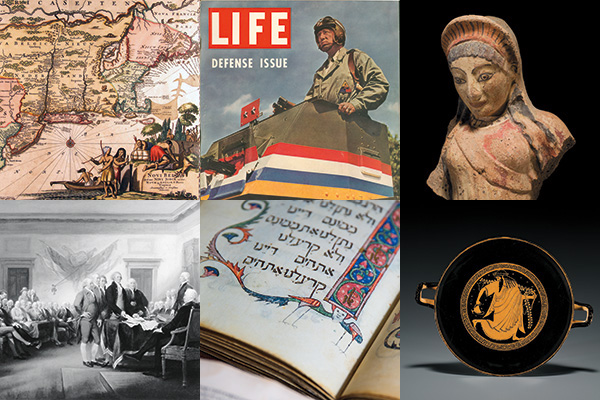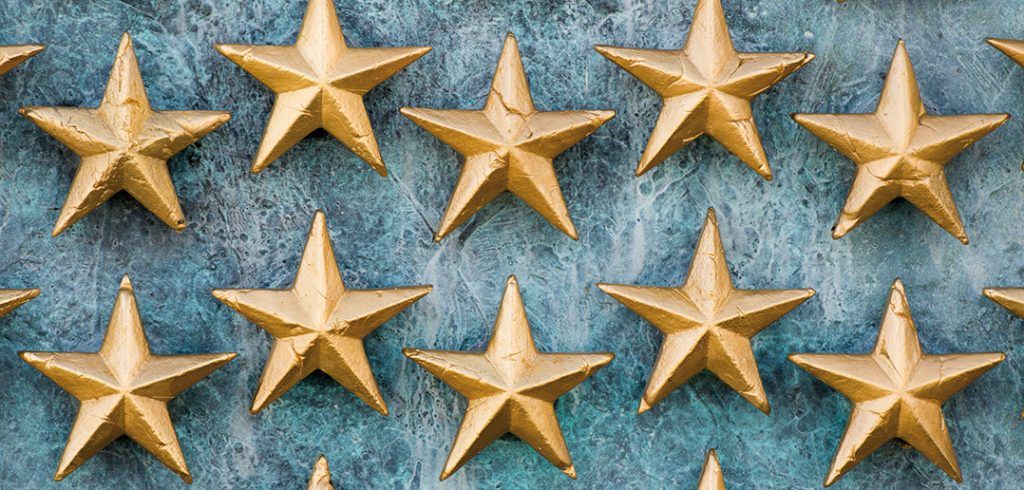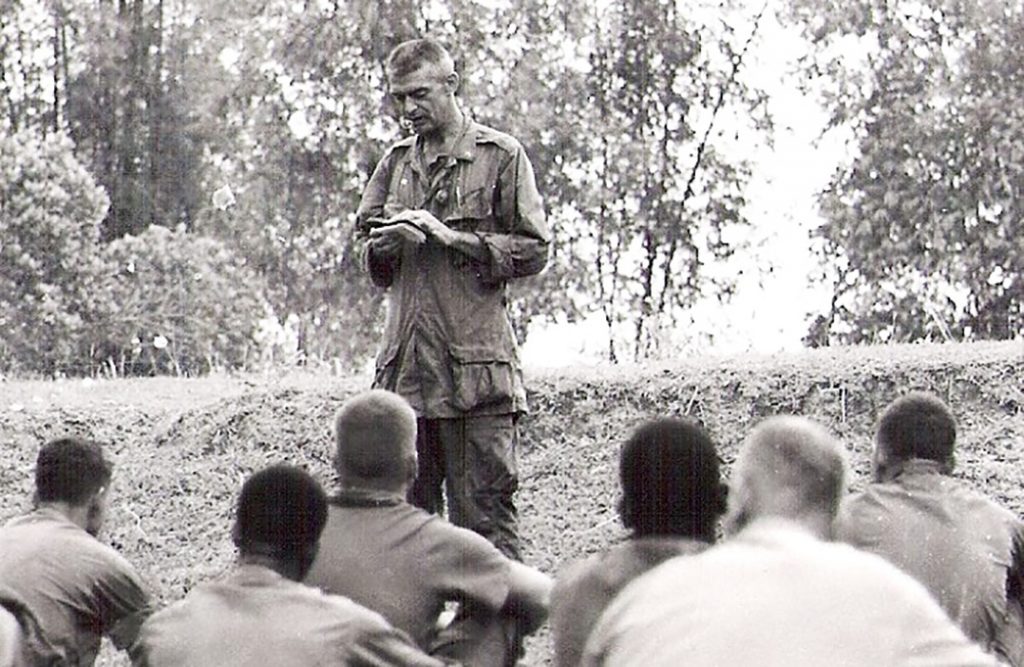44 to 49. Six Alumni Have Earned the Medal of Honor
Not only have Fordham alumni served the nation in every conflict since the Civil War, but six have earned the Medal of Honor, the nation’s highest military award: three for service during the Civil War, one during World War II, and two during the Vietnam War.
Gen. Jack Keane, GABELLI ’66, a retired four-star general and a former vice chief of staff of the U.S. Army, has called that “quite extraordinary.”
“I really believe we should take a hard look at Fordham in terms of those who have served in the military,” he has said. “They are not about war. They are about selfless service. In my judgment, they do it for a simple yet profound sense of duty, and they do it for one another. We can never take that for granted.”
44. The Grunt Padre
Though he never signed on for combat, Father Vincent Capodanno was a Vietnam War hero in the truest sense—a military chaplain, affectionately known as “the Grunt Padre,” who exhibited unparalleled bravery and never left the side of his men.
When he heard the North Vietnamese had ambushed his Marines, he rushed to the scene of the September 1967 battle in the Que Son Valley. A mortar shell shredded his right arm, yet the chaplain braved the heavy artillery to drag a hurt sergeant to safety. He quickly moved among the wounded and the dead, praying with the men and giving last rites to his fallen brothers, before he made the ultimate sacrifice. He was 38 years old.
Capodanno, who took evening classes at Fordham, received the Medal of Honor posthumously in January 1969. In 2006, the Archdiocese for the Military Services declared him a Servant of God, initiating the cause for his sainthood.
45. A Hero and an Advocate for Vets
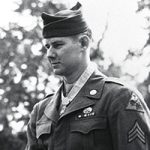 As a U.S. Army medic during World War II, Brooklyn native Thomas J. Kelly, UGE ’56, LAW ’62, saved 17 lives on April 5, 1945, by showing “gallantry and intrepidity in the face of seemingly certain death.” So reads his citation for the Medal of Honor, which he received seven months later. He would show that same spirit of service for the rest of his life by helping veterans and others who were affected by that titanic conflict.
As a U.S. Army medic during World War II, Brooklyn native Thomas J. Kelly, UGE ’56, LAW ’62, saved 17 lives on April 5, 1945, by showing “gallantry and intrepidity in the face of seemingly certain death.” So reads his citation for the Medal of Honor, which he received seven months later. He would show that same spirit of service for the rest of his life by helping veterans and others who were affected by that titanic conflict.
Soon after the war, he enrolled at Fordham, working his way through the Undergraduate School of Education over 10 years. After earning a Fordham law degree in 1962, he worked for the Veterans Administration for 36 years. He raised a family with his wife, Wilma; co-founded the Congressional Medal of Honor Society and served as its president; set up a fund to help widows and orphans of medal recipients; and organized events to raise money for veterans’ benefit. He died in 1988 and is buried in Arlington National Cemetery.
Mention of his medal made him think of the sacrifices of others, as was clear in his 1987 interview for the U.S. Army Medical Department’s oral history program: “I feel so bad,” he said, “about all the fellows that performed all those deeds deserving the Medal of Honor, who were never seen.”
46. A Noted Scholar and Judge
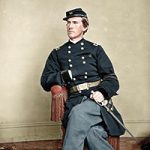 Martin T. McMahon graduated from Fordham in 1855 and, like many of his classmates, was drawn into the Civil War. In 1891, he received the Medal of Honor for bravery in the fighting near White Oaks Swamp, Virginia, on June 30, 1862. “Under fire of the enemy,” his citation reads, he “destroyed a valuable train that had been abandoned and prevented it from falling into the hands of the enemy.”
Martin T. McMahon graduated from Fordham in 1855 and, like many of his classmates, was drawn into the Civil War. In 1891, he received the Medal of Honor for bravery in the fighting near White Oaks Swamp, Virginia, on June 30, 1862. “Under fire of the enemy,” his citation reads, he “destroyed a valuable train that had been abandoned and prevented it from falling into the hands of the enemy.”
After the war, he served as corporation counsel for New York City, and in 1896 he was elected judge of the Court of General Sessions. Upon his death in 1906, The New York Times described him as a “noted soldier and judge” and “one of the conspicuous figures of the Civil War.”
47. A Leader of Men
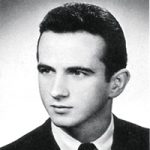 Robert Murray distinguished himself as a leader early in his short life—a distinction he would carry through to his last breath, in Vietnam, at the age of 23.
Robert Murray distinguished himself as a leader early in his short life—a distinction he would carry through to his last breath, in Vietnam, at the age of 23.
One of six children in a devout Catholic family, Murray attended Fordham Prep, where he served as a class officer for all four years and graduated with honors in 1964. Four years later, he earned a bachelor’s degree at Fordham College at Rose Hill.
On June 7, 1970, as an Army squad leader, he was searching for enemy mortar near the village of Hiep Duc when a soldier tripped an enemy grenade. “Instantly assessing the danger to the men of his squad,” his Medal of Honor citation reads, “Staff Sgt. Murray unhesitatingly and with complete disregard for his own safety, threw himself on the grenade, absorbing the full and fatal impact of the explosion. By his gallant action and self-sacrifice, he prevented the death or injury of the other members of his squad.”
48. A Man of Great Generosity
 After completing his studies at Fordham in 1862, Edwin M. Neville enlisted in the Union army. He was soon discharged due to an unspecified disability, but reenlisted in 1864 and rose to captain. He earned the Medal of Honor for capturing a Confederate flag at the Battle of Sailor’s Creek on April 6, 1865. Three days later, he was among those who escorted Union general Ulysses S. Grant to Appomattox Court House, where Grant accepted the surrender of Confederate general Robert E. Lee.
After completing his studies at Fordham in 1862, Edwin M. Neville enlisted in the Union army. He was soon discharged due to an unspecified disability, but reenlisted in 1864 and rose to captain. He earned the Medal of Honor for capturing a Confederate flag at the Battle of Sailor’s Creek on April 6, 1865. Three days later, he was among those who escorted Union general Ulysses S. Grant to Appomattox Court House, where Grant accepted the surrender of Confederate general Robert E. Lee.
Neville died in 1886 at the age of 43. An obituary writer praised him as “a man of great generosity, good address … and excellent business tact. And these qualities made him successful in almost anything he undertook.”
49. An Irish-American Patriot
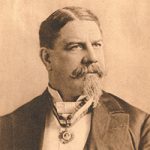 As class valedictorian in 1853, James R. O’Beirne exhorted his fellow Fordham graduates to honor their country and their alma mater. During the Civil War, he would show his Fordham loyalty when he brought coffee and Irish stew to captured former classmates who were serving in the Confederate Army.
As class valedictorian in 1853, James R. O’Beirne exhorted his fellow Fordham graduates to honor their country and their alma mater. During the Civil War, he would show his Fordham loyalty when he brought coffee and Irish stew to captured former classmates who were serving in the Confederate Army.
O’Beirne served in the 37th New York Regiment, the famed “Irish Rifles.” In 1863, he was seriously wounded at Chancellorsville, Virginia, and lay on the battlefield for three days. After recovering, he was made provost marshal of Washington, D.C., and in 1865 was involved in the pursuit that led to the capture of John Wilkes Booth, President Abraham Lincoln’s assassin. He received the Medal of Honor in 1891 for having “gallantly maintained the line of battle until ordered to fall back” at Fair Oaks, Virginia, in 1862.
After the war, O’Beirne worked in Washington, D.C., but left in 1890 to become U.S. commissioner of immigration at the Port of New York, where his duties included administration of the Ellis Island Immigration Examination Station. His return to the city of his youth allowed him to visit Rose Hill, where he impressed Fordham students with, as one undergraduate recalled, his “manly beauty … enhanced by a grandeur of soul.”
50. We Tie a Yellow Ribbon ’Round Our Ole Oak Tree
Approximately 400 military veterans and their dependents are enrolled at Fordham each year. Despite a national cap on VA benefits, Fordham has increased its Yellow Ribbon commitment to cover 100 percent of tuition and mandatory fees for all fully eligible post-9/11 veterans and their dependents.
51 to 54. Four Alumni Have Received the Medal of Freedom, the Nation’s Highest Civilian Award
On November 22, 2016, Vin Scully, FCRH ’49, became the fifth Fordham graduate to receive the honor. See this story about the award ceremony. See also item No. 136 in this feature, “Vin Scully Is the Dean of Fordham-Trained Sportscasters.”
51. A Man of Courage
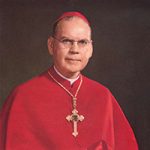 Terence Cardinal Cooke, GSAS ’57,
was born in New York City in 1921
and ordained a Catholic priest in 1945 by Fordham alumnus Francis Cardinal Spellman, archbishop of New York. During the early 1950s, Cooke taught
at Fordham’s Graduate School of Social Service. After Cardinal Spellman’s death in late 1968, at the height of the Vietnam War, Cooke was named archbishop of New York and, later, military vicar to the U.S. armed forces. He died of leukemia in 1983, and one year later, President Ronald Reagan awarded him the Medal of Freedom posthumously, calling him a “man of compassion, courage, and personal holiness.”
Terence Cardinal Cooke, GSAS ’57,
was born in New York City in 1921
and ordained a Catholic priest in 1945 by Fordham alumnus Francis Cardinal Spellman, archbishop of New York. During the early 1950s, Cooke taught
at Fordham’s Graduate School of Social Service. After Cardinal Spellman’s death in late 1968, at the height of the Vietnam War, Cooke was named archbishop of New York and, later, military vicar to the U.S. armed forces. He died of leukemia in 1983, and one year later, President Ronald Reagan awarded him the Medal of Freedom posthumously, calling him a “man of compassion, courage, and personal holiness.”
52. An Advocate for the Poor
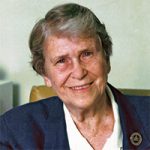 Sister M. Isolina Ferré, GSAS ’61, was born in Ponce, Puerto Rico, in 1914,
the youngest daughter of one of Puerto Rico’s wealthiest families. She entered the Missionary Servants of the Holy Trinity in 1935. In the 1950s, her work as a nun brought her to New York, where she earned a master’s degree in sociology at Fordham while gaining national recognition for her work with Puerto Rican youth gangs in Brooklyn.
Sister M. Isolina Ferré, GSAS ’61, was born in Ponce, Puerto Rico, in 1914,
the youngest daughter of one of Puerto Rico’s wealthiest families. She entered the Missionary Servants of the Holy Trinity in 1935. In the 1950s, her work as a nun brought her to New York, where she earned a master’s degree in sociology at Fordham while gaining national recognition for her work with Puerto Rican youth gangs in Brooklyn.
She later established community aid centers in Ponce, and in 1988 founded Trinity College of Puerto Rico, a school that provides leadership and vocational training. In August 1999, President Bill Clinton awarded her the Medal of Freedom, praising her ability to combine “her deep religious faith with her compassionate and creative advocacy for the disadvantaged.”
53. Father Mercy
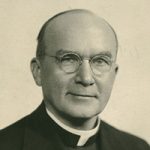 During the Japanese occupation of the Philippines from 1942 to 1945, when internment camps around Manila swelled with civilians and Allied prisoners, one Jesuit priest earned the nickname “Father Mercy” for his efforts to ease their suffering. The heroic work of that priest, John Fidelis Hurley, S.J., a 1914 Fordham graduate, would have an enduring impact on the welfare of the Philippine people.
During the Japanese occupation of the Philippines from 1942 to 1945, when internment camps around Manila swelled with civilians and Allied prisoners, one Jesuit priest earned the nickname “Father Mercy” for his efforts to ease their suffering. The heroic work of that priest, John Fidelis Hurley, S.J., a 1914 Fordham graduate, would have an enduring impact on the welfare of the Philippine people.
A native of New York City, Father Hurley served on the faculty of the Ateneo de Manila in the Philippines and in 1936 was named superior of the Jesuit mission in the country, a role he was performing when Japan invaded the Philippines in 1941.
Father Hurley not only resisted Japanese attempts to confiscate the Ateneo de Manila property but also ran a smuggling network that delivered food, medicine, and money to civilians and Allied soldiers being held in internment camps around Manila. He was eventually interrogated by the Japanese and interned in the Santo Tomas camp until 1945, when it was liberated by the U.S. Army.
He received the Medal of Freedom for his wartime efforts, and later served as the first secretary general of the Catholic Welfare Organization, a forerunner of Catholic Relief Services in the Philippines.
54. A Civil Rights Judge
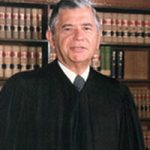 Irving R. Kaufman, FCRH ’28, LAW ’31, is perhaps best known as the federal judge who sentenced Julius and Ethel Rosenberg to death on April 5, 1951. But he also ruled in some landmark First Amendment, antitrust, and civil rights cases during four decades on the bench.
Irving R. Kaufman, FCRH ’28, LAW ’31, is perhaps best known as the federal judge who sentenced Julius and Ethel Rosenberg to death on April 5, 1951. But he also ruled in some landmark First Amendment, antitrust, and civil rights cases during four decades on the bench.
When he died in 1992 at age 81, The New York Times wrote, “It was Judge Kaufman’s hope that he would be remembered for his role not in the Rosenberg case, the espionage trial of the century, but as the judge whose order was the first to desegregate a public school in the North, who was instrumental in streamlining court procedures, who rendered innovative decisions in antitrust law and, most of all, whose rulings expanded the freedom of the press.”
In 1987, President Ronald Reagan awarded Kaufman the Medal of Freedom for his “exemplary service to our country” and “his multifaceted effort to promote an understanding of the law and our legal tradition.”
55. The Real-Life Hero of Bridge of Spies Went to Fordham
 From the 1940s until his untimely death in 1970, James B. Donovan brought intelligence, integrity, and courage to bear on some of the seminal events of his time. He is perhaps best known for giving legal representation to an accused Soviet spy, a principled but unpopular act that would later allow him to bring off one of the most famous “spy swaps” in history. This remarkable story is told in his bestselling memoir, Strangers on a Bridge, and in the 2015 film Bridge of Spies, which stars Tom Hanks as Donovan.
From the 1940s until his untimely death in 1970, James B. Donovan brought intelligence, integrity, and courage to bear on some of the seminal events of his time. He is perhaps best known for giving legal representation to an accused Soviet spy, a principled but unpopular act that would later allow him to bring off one of the most famous “spy swaps” in history. This remarkable story is told in his bestselling memoir, Strangers on a Bridge, and in the 2015 film Bridge of Spies, which stars Tom Hanks as Donovan.
Donovan died from a heart attack at age 53 on January 19, 1970. At the funeral Mass at St. Patrick’s Cathedral in New York City, Robert I. Gannon, S.J., former president of Fordham, shared his impressions of the “quiet, shrewd” former student: “I came to know Jim Donovan as the kind of student we had in mind when we started the place in 1841, the kind we wanted to graduate in 1937: intelligent, fearless, and good.”
56. The Real-Life Hero of Glory Was a Rose Hill Alumnus
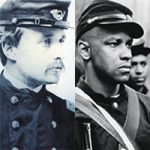 Born into a wealthy Boston family, Robert Gould Shaw attended the second division of St. John’s College, now known as Fordham Prep, after his family moved to New York in 1847.
Born into a wealthy Boston family, Robert Gould Shaw attended the second division of St. John’s College, now known as Fordham Prep, after his family moved to New York in 1847.
During the Civil War, he commanded the historic 54th Massachusetts Regiment, one of the first official regiments of black troops in the U.S. military. On July 18, 1863, along with two brigades of white troops, the 54th stormed the heavily guarded Fort Wagner, just outside of Charleston, South Carolina. Although Shaw was killed in battle with his men, his and his regiment’s bravery were immortalized by the 1989 film Glory, which featured Fordham alumnus Denzel Washington, FCLC ’77, in an Academy Award-winning performance as a fugitive slave who served in the regiment.
57. An Alumnus Helped Advance Peace in Northern Ireland
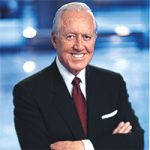 Optimism, faith, and an unwavering devotion to his family’s Irish heritage have inspired William J. Flynn, GSAS ’51, chairman emeritus of Mutual of America, to commit much of his lifetime to ending the violent conflict in Northern Ireland.
Optimism, faith, and an unwavering devotion to his family’s Irish heritage have inspired William J. Flynn, GSAS ’51, chairman emeritus of Mutual of America, to commit much of his lifetime to ending the violent conflict in Northern Ireland.
During the early 1990s, in an effort to help end the violence, Flynn sponsored a series of ads in The New York Times titled “Irish eyes are crying for peace.” This and other efforts paid off. In 1994, he attended both the IRA and Loyalist ceasefire announcements. And in 2010, Mary McAleese, then president of Ireland, praised Flynn, writing, “His contribution to the Peace Process in Northern Ireland has been simply immense.”
58. Sargent Shriver Has a Fordham Legacy
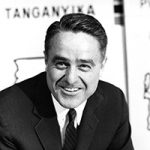 In February 1962, Sargent Shriver, the founding director of the Peace Corps, visited Fordham’s Rose Hill campus and told more than 700 students that the function of the new volunteer program was “to make a substantial contribution to humanity and to world peace,” The Ram reported. “We are in a struggle,” he said. “The traditional, ordinary, pedestrian way of doing things has got to be junked.”
In February 1962, Sargent Shriver, the founding director of the Peace Corps, visited Fordham’s Rose Hill campus and told more than 700 students that the function of the new volunteer program was “to make a substantial contribution to humanity and to world peace,” The Ram reported. “We are in a struggle,” he said. “The traditional, ordinary, pedestrian way of doing things has got to be junked.”
While it’s impossible to know how many Fordham students Shriver inspired that day, or on subsequent visits, his words did make a lasting impression on Ann Sheehan, UGE ’65, former executive director of Pennsylvania’s BCTV.
“Sarge hooked me completely,” she wrote upon his death in 2011. “There were applications available right there, in the gym, and I made my friend wait for me while I filled it out.” She served for two years in Togo, where she taught English as a second language. “It was a life-changing experience,” she wrote, “which is a statement made by just about everyone who’s been in the Peace Corps.”
59. 446 Alumni Have Served in the Peace Corps
In February 2016, Fordham was named to the list of universities that produce the most volunteers for the Peace Corps. With 15 alumni now serving worldwide, Fordham comes in at No. 18 out of 25 on the list of medium-size universities. As of fall 2016, a total of 446 Fordham alumni have served in the Peace Corps since its founding in 1961, including Joannah Caneda, FCRH ’06, LAW ’14, and Rob Gunther, FCRH ’06 (above), who were married in 2008 and served together in Ecuador.
